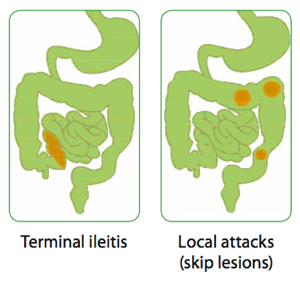What is Crohn’s Disease?
Crohn’s disease is a chronic (persistent) inflammatory disease which can occur anywhere in the gastrointestinal tract – from the mouth to the rectum.
It usually affects the rectum, colon and the lower parts of the small intestine (the terminal ileum). In very rare cases, the stomach, oesophagus or mouth may also be involved. Find out more about the digestive system.
For about a third of people with Crohn’s disease, only the large intestine is affected, in the other third, only the small intestine is affected. In a third of people with Crohn’s disease both the small and large intestines are affected.
The inflammation can extend deep into all the layers of the intestine. It can also ‘skip’ sections so there may be diseased sections separated by normal parts of the intestine.
Figure 1: Locations where Crohn’s disease can affect the intestines

Crohn’s disease shows more persistent symptoms than Ulcerative Colitis with increased abdominal pain and diarrhoea, particularly at meal times. Find out about ulcerative colitis.
FACT: Crohn’s disease is named after the American doctor, Burrill Bernard Crohn, who in 1932 wrote about the disease and called it regional ileitis (localised inflammation in the small intestine, which is called the ileum in Latin). Later the name of the disease was changed to Crohn’s disease in recognition of his work to understand the disease.
Who gets Crohn’s Disease?1
| Europe | 0.3 to 12.7 per 100,000 people |
| Asia and the Middle East | 0.04 to 5.0 per 100,000 people |
| North America | 0 to 20.2 per 100,000 people |
| Ages | Can develop at any age, but most commonly starts between the ages of 18 and 35 |
| Gender | Women and men equally |
| Other | Most frequently occurs in smokers – it is made worse by smoking. The risk for surgery is twice as high in smokers with the disease as non-smokers with the disease. Stopping smoking removes this increased risk. |
Researchers have discovered that Crohn’s disease tends to run in certain families. In fact, up to 20% of people with Crohn’s disease have a first-degree relative (first cousin or closer) with either Crohn’s disease or Ulcerative Colitis.
There is a genetic factor. The risk for children or siblings to get Crohn’s disease is about 10%, and 35% if both parent’s have the disease.
Symptoms
The symptoms vary in character depending on whether the disease is in the small intestine or the colon. It can often take a longer time from the appearance of first symptoms until diagnosis than for ulcerative colitis. This is because in the beginning the symptoms can be uncharacteristic, making the correct diagnosis difficult.
There is a greater tendency to abdominal pain and slightly less blood in the stools.
Symptoms include:
| Blood in the stools | Occasional |
| Diarrhoea | Loose, watery, or frequent bowel movements |
| Urgency to defecate | Present |
| Rectal bleeding | At times |
| Fever | At times |
| Pain | At times, usually in the lower right side of the abdomen, possibly with pain in the pelvis |
| Other |
|
Children who have Crohn’s disease may suffer delays in both growth and sexual development. Get information for caregivers of people with IBD.
References
1: Molodecky, N.A., Soon, I.S., Rabi, D.M., Ghali, W.A., Ferris, M., Chernoff, G., Benchimol, E.I., Panaccione, R., Ghosh, S., Barkema, H.W., et al. (2012). Increasing Incidence and Prevalence of the Inflammatory Bowel Diseases With Time, Based on Systematic Review. Gastroenterology 142, 46–54.e42.



